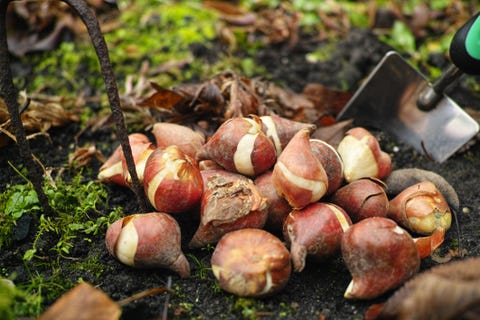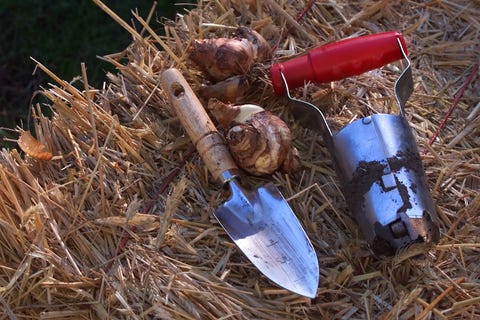How To Plan A Spring Bulb Garden
Bulbs are aneasy way of adding low-maintenance color to your garden. They're almost foolproof, too, because all you need to do is plant them and nature does the rest! Actually, the term "bulb" includes a whole bunch of different shapes and sizes of bulbs and bulb-like structures—including corms, tubers, and rhizomes, which all look different from each other. But they all provide energy for a plant to grow and bloom in a season (and sometimes to rebloom the next year).
The most important factor is knowing when to plant your bulbs. Some, such as elephant ear and gladiolus, are planted in spring for a summer show that same year. Other types of bulbs such as tulips and daffodils need to be planted in the fall to bloom the following spring; these typically require a period of "chilling" or cold weather to flower. That means in areas with warm winters, they must be purchased "pre-chilled" from the nursery. (You can DIY the chill period, too, but it takes 2 to 4 months and steals space from your fridge).
Here's what else you need to know about planting flowering bulbs:
Buy quality bulbs.
This is definitely a case of you get what you pay for. Quality bulbs from nurseries will result in more flowers, while cheapo bulbs often won't sprout or will give a lackluster performance with few (or no) flowers. When choosing in person or if you've bought some online, inspect the bulbs to make sure they're firm with the papery outer skin intact. Skip those that are mushy or moldy. And plant them as soon as possible. If you have to store them for a few weeks before you can plant, place them somewhere dry and cool away from direct sunlight. When you order from online nurseries, they typically send the bulbs at the right time to plant in your region.

barmalini Getty Images
Pick the right spot in your garden.
Many bulbs need full sun; that's an area that gets at least 6 hours of direct sunlight a day. But a few require part shade, so read the plant tag or description to know what you're buying. Don't forget that many areas of your garden are full-sun in the spring when deciduous trees haven't leafed out yet, but then change to part shade in summer. Before you plant, make sure the soil in the area is well-drained, not soggy, because bulbs don't like wet feet.
When do I plant flower bulbs?
Plant spring-flowering bulbs in fall for a colorful garden next spring. These bulbs can be put in the ground in early to late autumn before the ground freezes—basically, as long as you can still dig a hole and drop the bulb in, you're good. Summer flowering bulbs should be planted after the danger of frost is past where you live. Check with your university coop extension service (find yours here) to learn the last estimated frost date in your region.

Star Tribune via Getty Images Getty Images
How deep should I plant flower bulbs?
Generally, bulbs go in the ground at a depth of 2 to 3 times the height of the bulb. Use a garden trowel or bulb planter to make the hole, then place them in it pointy-side up. Some bulbs, such as crocus corms, look like a squished grape, so it can be difficult to tell which end is up. If you can't figure it out, plant the bulb on its side and the plant will figure it out on its own and still sprout.
Next, cover the bulb with soil, gently pat down, and water. For a more natural, lush appearance in your garden, plant them in clusters rather than one bulb here, one bulb there. If you dig around in your garden a lot, it's also smart to put markers where you've planted bulbs so you don't accidentally dig them up before they sprout. While some people add bulb fertilizer to the hole, it's not entirely necessary. In fact, some growers say it tends to produce more foliage and fewer flowers.
Let the bulb's leaves die back naturally.
We know it's tempting to cut back the foliage after the flowers fade, but that's a big fat no-no. The bulb needs to make food to bloom next year. You can, however, cut off the dead flower heads so the plant doesn't transfer energy into making seeds. If withering leaves bother you, interplant bulbs with annuals and perennials since those will hide the fading foliage. Some bulbs, such as tulips, may not return again next year; they're generally treated as annuals, like petunias or marigolds, and enjoyed for one season.
Dig up tender summer-flowering bulbs after the first frost.
Some types of summer flowering bulbs, such as dahlias and ranunculus, cannot survive cold winters. In northern climates, gently lift them from the soil with a digging fork in the fall after a frost. Shake off loose soil and let bulbs dry a few days before storing somewhere dark and dry at temperatures around 60 to 70 degrees until you plant them again next spring.
What You Need to Plant Bulbs
Follow House Beautiful on Instagram.
Arricca Elin Sansone Arricca SanSone has written about health and lifestyle topics for Prevention, Country Living, Woman's Day, and more.
This content is created and maintained by a third party, and imported onto this page to help users provide their email addresses. You may be able to find more information about this and similar content at piano.io
How To Plan A Spring Bulb Garden
Source: https://www.housebeautiful.com/lifestyle/gardening/a32688576/how-to-plant-bulbs/
Posted by: lomaxbuting.blogspot.com

0 Response to "How To Plan A Spring Bulb Garden"
Post a Comment